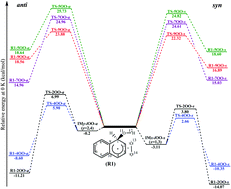Theoretical study of the oxidation mechanisms of naphthalene initiated by hydroxyl radicals: the O2 addition reaction pathways†
Abstract
Atmospheric oxidation of the naphthalene–OH adduct [C10H8OH]˙ (R1) by molecular oxygen in its triplet electronic ground state has been studied using density functional theory along with the B3LYP, ωB97XD, UM05-2x and UM06-2x exchange–correlation functionals. From a thermodynamic viewpoint, the most favourable process is O2 addition at the C2 position in syn mode, followed by O2 addition at the C2 position in anti mode, O2 addition at the C4 position in syn mode, and O2 addition at the C4 position in anti mode, as the second, third and fourth most favourable processes. The syn modes of addition at these positions are thermodynamically favoured over the anti ones by the formation of an intramolecular hydrogen bond between the hydroxyl and peroxy substituents. Analysis of the computed structures, bond orders and free energy profiles demonstrate that the reaction steps involved in the oxidation of the naphthalene–OH adduct by O2 satisfy Hammond's principle. Kinetic rate constants and branching ratios under atmospheric pressure and in the fall-off regime have been supplied, using transition state and RRKM theories. By comparison with experiment, these data confirm the relevance of a two-step reaction mechanism. Whatever the addition mode, O2 addition in C4 position is kinetically favoured over O2 addition in C2 position, in contrast with the expectations drawn from thermodynamics and reaction energies. Under a kinetic control of the reaction, and in line with the computed reaction energy barriers, the most efficient process is O2 addition at the C4 position in syn mode, followed by O2 addition at the C2 position in syn mode, O2 addition at the C4 position in anti mode, and O2 addition at the C2 position in anti mode as the second, third and fourth most rapid processes. The computed branching ratios also indicate that the regioselectivity of the reaction decreases with increasing temperatures and decreasing pressures.


 Please wait while we load your content...
Please wait while we load your content...